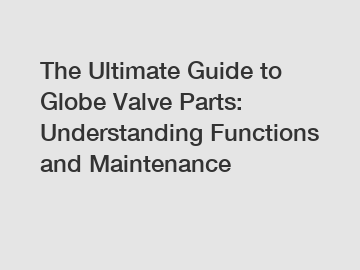The Ultimate Guide to Globe Valve Parts: Understanding Functions and Maintenance
Globe valves are widely used in various industries as essential components for regulating the flow of fluids. Their intricate design and precise functionality make them critical in controlling the flow rates and pressures within a system. To fully understand and appreciate this vital valve type, it is essential to gain comprehensive knowledge about its various parts, their functions, and the crucial maintenance required for ensuring optimal performance. In this ultimate guide, we will delve into the world of globe valve parts, providing you with a detailed overview of their importance and how to keep them in top shape.
1. The Anatomy of a Globe Valve.
To comprehend the mechanisms behind globe valves, we must first familiarize ourselves with their core components:

a) Body: Also known as the shell, the body serves as the primary structure that houses the internal parts of the valve. It provides stability and supports the necessary connections.
b) Bonnet: The bonnet encompasses the stem and packing, ensuring a tight seal to prevent fluid leakage.
c) Disc: The disc, which controls the flow, is connected to the valve stem within the body. The movement of the stem raises or lowers the disc to regulate fluid passage.
d) Stem: The stem is responsible for transmitting the motion to the disc. It connects the actuator outside the valve to the disc inside the body.
e) Seat: The seat forms the sealing surface and collaborates with the disc to control fluid flow. The interaction between the seat and disc determines the valve's flow characteristic.
2. Understanding the Functions of Globe Valve Parts.
Now that we've identified the key parts of a globe valve, let's explore their functions in more detail:
a) Body: The body provides support and serves as the main container for the operational parts. It also determines the connection type and compatibility with the surrounding system.
b) Bonnet: As the valve's protective cover, the bonnet ensures a secure closure and prevents the escape of fluid. It can be of various designs, including bolted, welded, or pressure-sealed, depending on the application requirements.
c) Disc: The disc, controlled by the valve stem's movement, allows for precise regulation of fluid flow. By raising or lowering the disc, the desired flow rate and pressure within the system can be achieved.
d) Stem: The stem acts as the connection between the valve actuator and the disc. Its rotary or linear motion determines the position of the disc, ensuring optimal flow control.
e) Seat: The seat creates a seal with the disc, preventing any leakage when the valve is in the closed position. It plays a crucial role in maintaining the tight shut-off characteristic of the valve.
3. Crucial Maintenance for Globe Valve Longevity.
To maintain the efficiency and longevity of globe valves, regular maintenance is essential. Here are some key tips to follow:
a) Lubrication: Ensure proper lubrication of valve stems to minimize friction and ensure smooth movement. Regular application of suitable lubricants prevents wear and tear, ultimately extending the valve's lifespan.
b) Inspection: Conduct periodic inspections of all valve parts, such as the bodies, bonnets, discs, stems, and seats, to identify any signs of corrosion, erosion, or damage. Timely detection allows for prompt repairs or replacements, avoiding potential system failure.
c) Packing Replacement: As the bonnet packing may wear out over time, it is crucial to replace it when necessary to prevent leakage. Use high-quality packing materials that can withstand the operating conditions of the valve.
d) Cleaning: Regularly clean the valve to remove any debris, sediment, or foreign particles that may hinder its performance. Implement a thorough cleaning process, ensuring that all parts are adequately disassembled, cleaned, and reassembled correctly.
Conclusion.
A comprehensive understanding of globe valve parts and their functions is crucial for maintaining effective and efficient fluid control systems. By grasping the intricacies of each component, we can better appreciate their importance in proper valve operation. Remember to adhere to regular maintenance procedures to ensure the longevity and reliability of globe valves within industrial applications. Regular inspections and necessary repairs will help avoid system failures, promoting a smooth workflow and minimizing downtime. With this ultimate guide to globe valve parts, you are equipped with the knowledge to optimize your system's performance and make well-informed decisions regarding maintenance and replacement, ensuring the seamless operation of your fluid control processes.
If you are looking for more details, kindly visit China gate valve vs globe valve factory, China pneumatic actuator for ball valve manufacturer, China electro pneumatic ball valve factory.
189
0
0

Comments
All Comments (0)